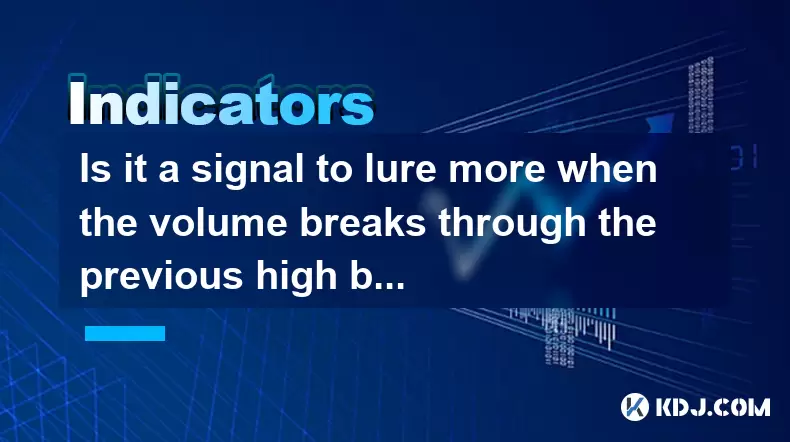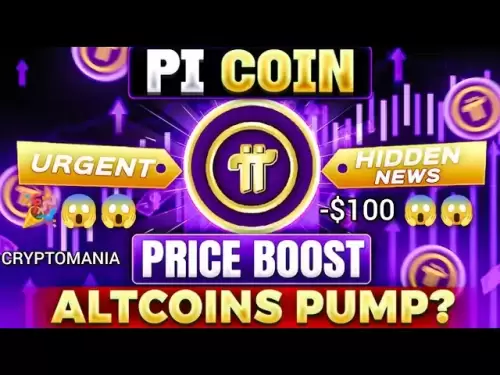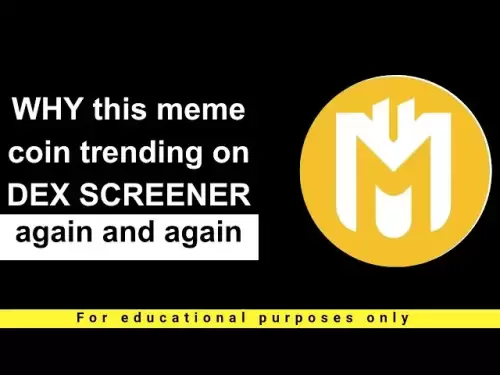-
 Bitcoin
Bitcoin $109,330.5032
0.89% -
 Ethereum
Ethereum $2,661.8271
3.39% -
 Tether USDt
Tether USDt $1.0006
0.04% -
 XRP
XRP $2.3808
4.11% -
 BNB
BNB $663.3047
0.75% -
 Solana
Solana $154.6074
2.96% -
 USDC
USDC $1.0001
0.02% -
 TRON
TRON $0.2876
0.47% -
 Dogecoin
Dogecoin $0.1736
2.37% -
 Cardano
Cardano $0.6105
5.06% -
 Hyperliquid
Hyperliquid $39.2542
4.13% -
 Sui
Sui $2.9702
3.11% -
 Bitcoin Cash
Bitcoin Cash $507.3879
0.84% -
 Chainlink
Chainlink $14.0303
3.57% -
 Stellar
Stellar $0.2912
14.83% -
 UNUS SED LEO
UNUS SED LEO $9.0547
-0.25% -
 Avalanche
Avalanche $18.6501
3.24% -
 Hedera
Hedera $0.1702
6.77% -
 Shiba Inu
Shiba Inu $0.0...01213
2.66% -
 Toncoin
Toncoin $2.8233
2.12% -
 Litecoin
Litecoin $88.6781
2.43% -
 Monero
Monero $321.5220
2.77% -
 Polkadot
Polkadot $3.5388
4.44% -
 Dai
Dai $1.0002
0.02% -
 Ethena USDe
Ethena USDe $1.0010
0.07% -
 Uniswap
Uniswap $8.2247
8.18% -
 Bitget Token
Bitget Token $4.3451
1.00% -
 Aave
Aave $298.6045
4.39% -
 Pepe
Pepe $0.0...01035
3.13% -
 Pi
Pi $0.4643
1.47%
Is it a signal to lure more when the volume breaks through the previous high but the closing falls?
2025/06/29 19:28

Understanding Volume and Price Behavior in Cryptocurrency Trading
In the world of cryptocurrency trading, volume and price are two of the most critical indicators used to assess market sentiment. Volume refers to the total number of coins traded over a specific period, while price reflects the value at which those coins are exchanged. When volume spikes significantly—especially when it breaks through a previous high—it often signals strong interest from traders or investors.
However, if the closing price falls despite this surge in volume, it raises questions about the nature of that buying or selling pressure. This phenomenon can be interpreted in different ways depending on the context, such as market structure, order flow, and trader psychology. The key lies in understanding whether this divergence is a sign of accumulation, distribution, or manipulation.
Important: In crypto markets, where volatility is common and liquidity can shift rapidly, interpreting volume must always be done in tandem with price action and other technical tools.
What Happens When Volume Surpasses Previous Highs?
When volume surpasses a prior peak, it typically indicates heightened activity in the asset. In many cases, this can precede a breakout in price, either upward or downward. However, not all high-volume days lead to clear directional moves. Sometimes, even with significant volume, the price may close lower than its opening level.
This kind of behavior can occur for several reasons:
- Large whale transactions taking place off-exchange but recorded on-chain.
- FOMO-driven retail buying followed by quick profit-taking.
- Manipulation via wash trading or spoofing orders to create artificial volume.
It's crucial to differentiate between real volume (organic trades) and manipulated volume (fake or incentivized trades). Many altcoins suffer from inflated volume metrics due to exchanges inflating their statistics to attract more users.
Important: Always cross-check volume data using platforms like CoinGecko or CoinMarketCap, which filter out fake volumes.
Why Does the Closing Price Fall Despite High Volume?
A drop in closing price despite high volume can signal various scenarios:
- Profit-taking after a rally: Traders who bought earlier may be selling off their holdings once they see increased participation.
- Bearish engulfing patterns: A candlestick pattern where a large bullish candle is followed by a larger bearish one, indicating reversal potential.
- Distribution phase: Smart money or whales might be selling into strength created by retail buyers.
In such situations, the market might be setting up for a pullback or consolidation phase. If this occurs near resistance levels or after a substantial run-up, it could indicate that sellers are regaining control.
Important: Look for signs of rejection at key resistance levels—such as long upper wicks or dark cloud cover candlesticks—to confirm weakening momentum.
Is It a Lure to Attract More Buyers?
The scenario described—where volume surges past previous highs but price closes lower—can indeed act as a lure for new buyers. Here’s how:
- False breakouts: The sudden spike in volume and price may trigger stop-losses or automated trading bots, drawing in more participants.
- Psychological traps: Retail traders seeing rising volume and initial gains may jump in, only to find themselves stuck when the price reverses.
- Liquidity absorption: Large players may absorb available buy orders before pushing the price in the opposite direction.
This kind of behavior is commonly observed in low-cap cryptocurrencies, where large holders (whales) can manipulate the market relatively easily compared to major assets like Bitcoin or Ethereum.
Important: Watch for sudden spikes in volume without corresponding price increases—they can be early warnings of manipulative tactics.
How to Analyze This Scenario Step-by-Step
To better understand whether the situation described is a lure or a genuine signal, follow these steps:
- Check the chart time frame: Is this happening on a daily, hourly, or 15-minute chart? Shorter time frames are more prone to noise and manipulation.
- Identify support and resistance levels: Is the price near a key psychological or historical level? If so, the reaction might be stronger.
- Analyze candlestick patterns: Look for signs of rejection, indecision, or engulfing formations around the volume spike.
- Compare volume with average volume: If the spike is significantly higher than usual, it may warrant closer attention.
- Use on-chain analytics: Platforms like Glassnode or Santiment can provide insights into real-time chain activity, helping distinguish real from fake volume.
Important: Never rely solely on volume or price alone. Combine them with on-chain data, order book depth, and macro-level sentiment analysis for a comprehensive view.
Frequently Asked Questions
Q: Can I use volume alone to make trading decisions in crypto?
No, volume should never be used in isolation. It must be analyzed alongside price movement, chart patterns, and possibly on-chain metrics to form a complete picture.
Q: How do I know if the volume is manipulated?
You can check third-party platforms like CoinGecko or CoinMarketCap that audit exchange volumes. Also, look for discrepancies between price and volume trends—real volume usually supports meaningful price moves.
Q: Should I sell immediately if price drops after a volume spike?
Not necessarily. It depends on your strategy and risk tolerance. Some traders wait for confirmation of a trend reversal before exiting positions. Use stop-loss orders and trailing stops to manage exposure.
Q: Are certain cryptocurrencies more prone to this kind of volume-price divergence?
Yes, smaller-cap altcoins with less liquidity and fewer institutional participants are more vulnerable to such anomalies. Major cryptocurrencies like BTC and ETH tend to have more organic volume and price correlation.
免責聲明:info@kdj.com
所提供的資訊並非交易建議。 kDJ.com對任何基於本文提供的資訊進行的投資不承擔任何責任。加密貨幣波動性較大,建議您充分研究後謹慎投資!
如果您認為本網站使用的內容侵犯了您的版權,請立即聯絡我們(info@kdj.com),我們將及時刪除。
- 加密貨幣清算和比特幣的瘋狂騎行:下一步是什麼?
- 2025-07-10 12:30:12
- 埃隆·馬斯克(Elon Musk),花生大鼠和pnut token:加密和政治中的瘋狂騎行
- 2025-07-10 12:30:12
- BlockDag領導加密貨包:2025年Blockdag,Cardano,Litecoin和Polkadot的前景
- 2025-07-10 10:50:12
- Ondo Price觀察:貿易商的眼睛鑰匙阻力潛在的3美元目標
- 2025-07-10 10:50:12
- 比特幣與巴西真實:在關稅戰爭中導航波動
- 2025-07-10 11:10:12
- 風險投資公司,比特幣和資金:加密貨幣未來的紐約分鐘
- 2025-07-10 11:10:12
相關知識

How to trade Dogecoin based on funding rates and open interest
2025-07-07 02:49:34
<h3>Understanding Funding Rates in Dogecoin Trading</h3><p>Funding rates are periodic payments made to either long or short traders ...

What is the 'God Mode' indicator for Dogecoin
2025-07-07 16:42:48
<h3>Understanding the 'God Mode' Indicator</h3><p>The 'God Mode' indicator is a term that has emerged within cryptocurrency trading ...

Using Gann Fans on the Dogecoin price chart
2025-07-07 21:43:10
<h3>Understanding Gann Fans and Their Relevance in Cryptocurrency Trading</h3><p>Gann Fans are a technical analysis tool developed b...

How to spot manipulation on the Dogecoin chart
2025-07-06 12:35:49
<h3>Understanding the Basics of Chart Manipulation</h3><p>Chart manipulation in the cryptocurrency space, particularly with Dogecoin...

Dogecoin market structure break explained
2025-07-07 02:51:32
<h3>Understanding the Dogecoin Market Structure</h3><p>Dogecoin, initially created as a meme-based cryptocurrency, has evolved into ...

How to backtest a Dogecoin moving average strategy
2025-07-08 04:50:05
<h3>What is a Moving Average Strategy in Cryptocurrency Trading?</h3><p>A moving average strategy is one of the most commonly used t...

How to trade Dogecoin based on funding rates and open interest
2025-07-07 02:49:34
<h3>Understanding Funding Rates in Dogecoin Trading</h3><p>Funding rates are periodic payments made to either long or short traders ...

What is the 'God Mode' indicator for Dogecoin
2025-07-07 16:42:48
<h3>Understanding the 'God Mode' Indicator</h3><p>The 'God Mode' indicator is a term that has emerged within cryptocurrency trading ...

Using Gann Fans on the Dogecoin price chart
2025-07-07 21:43:10
<h3>Understanding Gann Fans and Their Relevance in Cryptocurrency Trading</h3><p>Gann Fans are a technical analysis tool developed b...

How to spot manipulation on the Dogecoin chart
2025-07-06 12:35:49
<h3>Understanding the Basics of Chart Manipulation</h3><p>Chart manipulation in the cryptocurrency space, particularly with Dogecoin...

Dogecoin market structure break explained
2025-07-07 02:51:32
<h3>Understanding the Dogecoin Market Structure</h3><p>Dogecoin, initially created as a meme-based cryptocurrency, has evolved into ...

How to backtest a Dogecoin moving average strategy
2025-07-08 04:50:05
<h3>What is a Moving Average Strategy in Cryptocurrency Trading?</h3><p>A moving average strategy is one of the most commonly used t...
看所有文章

























































































